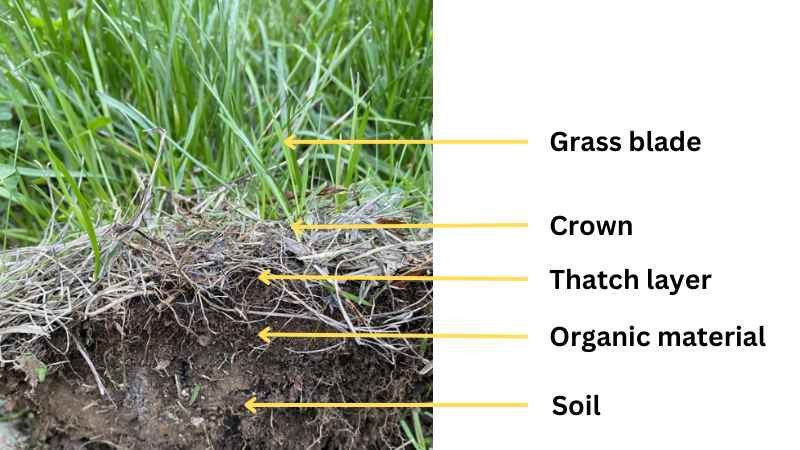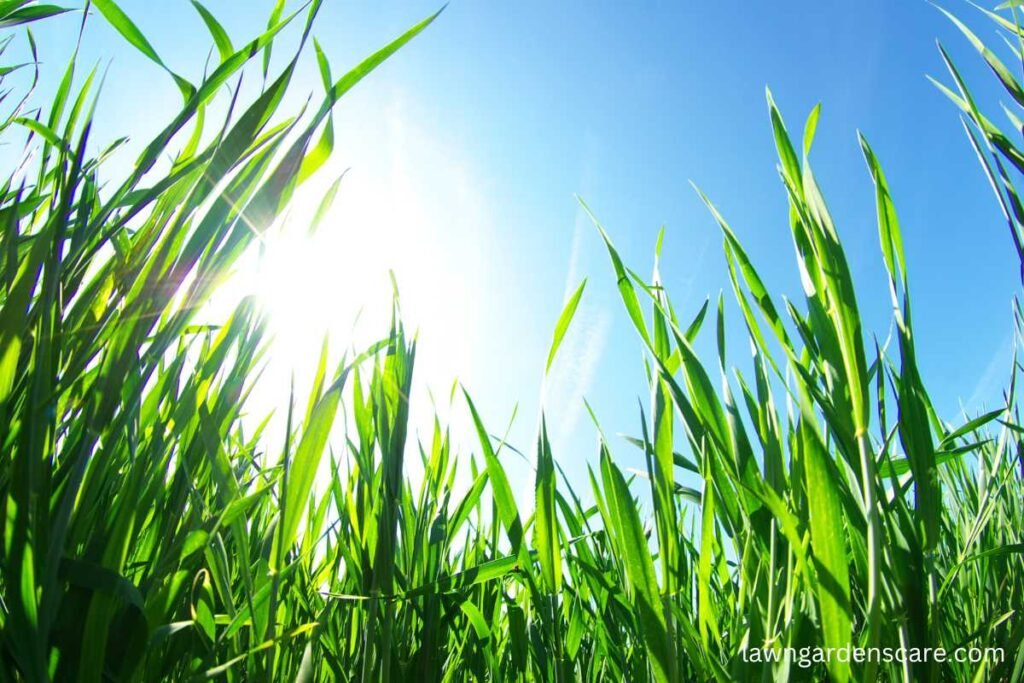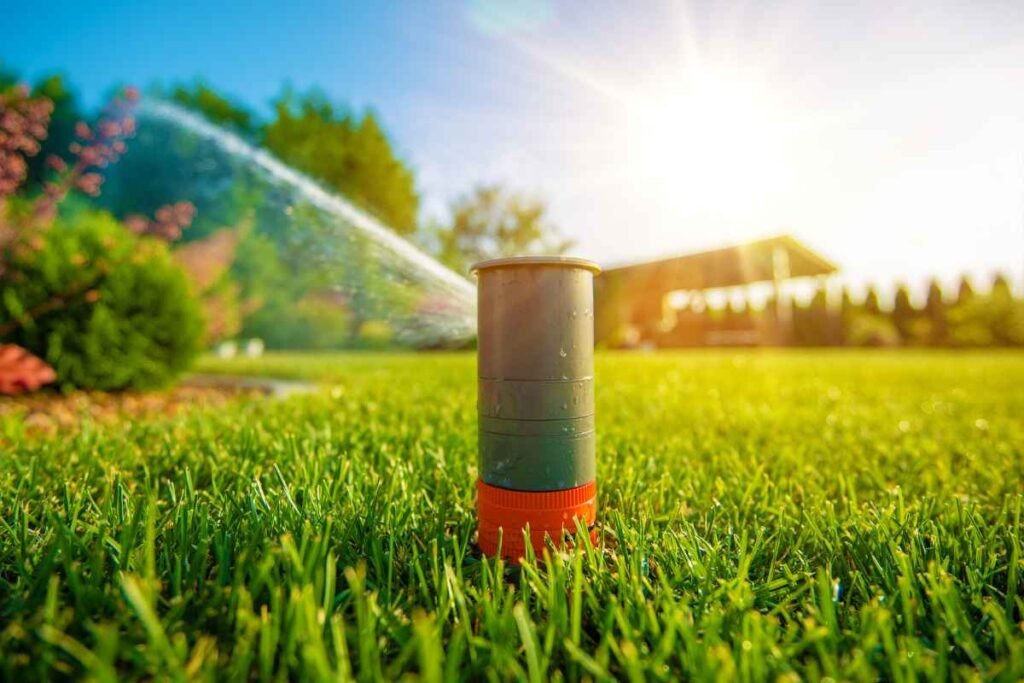Maintaining a healthy and vibrant lawn involves various essential practices, and one of the most critical is dethatching. Dethatching removes the dense layer of dead grass, roots, and organic matter, allowing your lawn to thrive. In this article, we address frequently asked questions about dethatching, providing you with the information needed to keep your lawn in top condition and ensure its long-term health and beauty.
Dethatching a Lawn FAQs

What is Thatch?
Thatch is a dense layer of dead grass, roots, and organic matter, which can accumulate over time on top of the soil. A thin layer (less than ½ inch) of thatch can be beneficial, protecting the soil and reducing water evaporation.
What Causes Of Thatch?
Thatch buildup is caused by several factors, including:
- Poor Soil Preparation: Compacted soil hinders root penetration. Tilling, grading, and watering must be done before planting sod or seed. Construction machinery and traffic can compact even sandy soils. Compacted soils cause shallow roots and thatch.
- Rapid Growth: When grass grows quickly, particularly during its peak seasons, it sheds roots and shoots faster than they can decompose.
- Mowing: The higher you mow, the greater the tendency to develop thick.
- Excessive Nitrogen: Over-fertilizing with high-nitrogen fertilizers can speed up grass growth, leading to more thatch.
- Poor Decomposition: Inadequate soil microorganisms can slow the breakdown of organic matter, contributing to thatch accumulation.
- Frequent Watering: Light, frequent watering encourages shallow root systems and contributes to thatch.
- Type of Grass: Some grass varieties, like Kentucky bluegrass and creeping fescue, naturally produce more thatch. Bentgrass and vigorous varieties of Kentucky bluegrass produce thatch faster than older types. Fine fescue grasses are slow growers but tend to form thatch due to their high lignin content.
Isn’t Thatch Good Thing?
Yes, a thin layer of thatch can be beneficial. However, excessive thatch (more than ½ inch) can create a barrier that prevents water, nutrients, and air from reaching the soil, leading to unhealthy grass.
What Does Dethatching A Lawn Mean?
Dethatching a lawn refers to the process of removing the layer of thatch that builds up between the soil and the grass. Thatch consists of dead grass, roots, and other organic matter that can accumulate over time. A little thatch insulates against changes in temperature and foot traffic, but excessive amounts can block water, nutrients, and air from reaching the soil and grass roots. This can cause poor grass growth, insect and disease susceptibility, and an unhealthy lawn.
What Is The Difference Between Dethatching And Aeration?
Dethatching removes the layer of dead grass and organic debris that accumulates between the soil and grass blades, allowing better water, nutrient, and air penetration. It involves using specialized rakes or power dethatchers. Aeration, on the other hand, relieves soil compaction by creating small holes in the soil using core or spike aerators, promoting deeper root growth and improved soil health. While dethatching addresses surface-level issues by removing excess thatch, aeration enhances soil structure and root development.
Dethatch or Core Aeration First: Does It Matter?
The order of dethatching and core aeration depends on the thickness of the thatch. If the thatch is over half an inch thick, it’s best to dethatch first to clear the way, making aeration more effective. Aeration after dethatching can then better alleviate soil compaction, enhancing nutrient, air, and water flow to the roots. If the thatch is not too thick, you might aerate first to improve soil conditions before dethatching.
How Critical Is Thatch For A Good Lawn?
A 1/2-inch covering of thatch insulates against temperature variations, retains moisture, and decreases foot traffic compaction. However, thatch thicker than 1/2 inch can block water, nutrients, and air from reaching the soil and grassroots. This can damage grass, make it susceptible to pests and diseases, and make the lawn unhealthy.
What Happens if You Never Dethatch Your Lawn?
If you never dethatch, the thick thatch layer can:
- Prevent Water and Nutrient Absorption: Thatch acts as a barrier, blocking water, nutrients, and air from reaching the soil.
- Increase Disease and Pest Risks: Thatch provides a habitat for pests and diseases.
- Suffocate Grass Roots: Grass may become weak and unhealthy due to lack of essential resources.
How Do I Know if My Lawn Needs Dethatching?
To determine if your lawn needs dethatching, dig a small section of the lawn and measure the thatch layer. If the thatch is more than 1/2 inch thick, it’s time to dethatch. Symptoms of excessive thatch include poor water absorption, spongy feel underfoot, and patches of unhealthy grass. Signs to watch for:
- Spongy Feel: If your lawn feels spongy or bouncy when walked on, it likely has a thick thatch layer.
- Poor Drainage: Water pooling or slow drainage can indicate excessive thatch.
- Discoloration and Weak Growth: Despite watering and fertilizing, grass that is pale, thin, or slow-growing may have thatch buildup..
How Often Should You Dethatch Your Lawn?
The frequency of dethatching depends on the type of grass and the amount of thatch accumulation. Generally, most lawns benefit from dethatching every 1 to 3 years, when the thatch layer exceeds 1/2 inch in thickness. Cool-season grasses, like Kentucky bluegrass and fescue, typically require less frequent dethatching, while warm-season grasses, like Bermuda and zoysia, may need it more often due to their faster growth rates. Over-dethatching can stress the lawn, so only dethatch when necessary.
What is the Best Month to Dethatch Your Lawn?
The best time to dethatch your lawn is during the grass’s active growth period (This timing allows the lawn to recover quickly):
- Cool-Season Grasses (e.g., Kentucky Bluegrass, Fescue): Early spring or early fall, when these grasses are actively growing, is ideal for dethatching.
- Warm-Season Grasses (e.g., Bermuda, Zoysia): Late spring to early summer is the best time, as these grasses enter their peak growing season.
Can You Dethatch When It’s Wet?
It’s not recommended to dethatch your lawn when it’s wet. Wet conditions can lead to pulling out healthy grass and compacting the soil, making the process less effective and potentially damaging the lawn. Wait until the lawn is dry to ensure efficient dethatching and to minimize damage.
Dethatching Lawn: How To
- Mow the Lawn: Begin by mowing your lawn to about half its usual height. This makes it easier for the dethatcher to access the thatch layer.
- Dethatcher Selection: Choose a dethatching rake for small lawns or a power dethatcher for larger areas.
- Set the Depth: Adjust the dethatcher’s blades or tines to lightly touch the soil surface, typically around 1/4 to 1/2 inch deep.
- Dethatching Process: Use the dethatcher to comb through the grass, lifting and removing the thatch layer.
- Rake and Collect Debris: After dethatching, rake up the loosened thatch and dispose of it properly.
- Water and Fertilize: Water your lawn thoroughly and apply a balanced fertilizer to promote recovery and healthy growth.
How Much Does Dethatching a Lawn Cost?
The cost of dethatching a lawn varies based on several factors, including the size of the lawn, the method used, and whether you hire a professional or do it yourself.
- DIY Cost: Renting a power dethatcher can cost between $50 to $80 per day. Purchasing a dethatching rake can cost around $30 to $50.
- Professional Services: Hiring a professional service can cost between $100 to $200 per hour, with total costs depending on the lawn size and the extent of thatch buildup.
Dethatcher: How to Use
- Preparation: Mow the lawn to half its normal height.
- Set Depth: Adjust the dethatcher’s depth setting so the blades lightly touch the soil.
- Dethatching: Operate the dethatcher in straight lines across the lawn. For effective coverage, overlap each pass slightly.
- Rake and Collect: After dethatching, rake up the thatch debris and dispose of it.
How to Use Dethatching Rake?
- Manual Effort: Use the rake to manually pull up the thatch layer.
- Raking Technique: Work in one direction, covering small sections of the lawn at a time.
- Debris Removal: Collect and dispose of the thatch debris after raking.
Lawn Dethatcher: What Does It Do?
A lawn dethatcher uses blades or tines to cut through and lift the thatch layer from the lawn. This allows air, water, and nutrients to reach the soil and grass roots more effectively.
Lawn Dethatcher: How Does It Work?
A lawn dethatcher works by using rotating blades or tines to slice through and lift the thatch layer. The blades are set to a specific depth to avoid damaging the soil and grass roots while effectively removing the thatch.
How Many Passes with Dethatcher?
Typically, one to two passes over the lawn are sufficient to remove the thatch layer effectively. More passes might be necessary for lawns with very thick thatch buildup, but excessive dethatching can damage the lawn.
How Low Should I Set My Dethatcher?
Set the dethatcher blades or tines to lightly touch the soil surface, usually around 1/4 to 1/2 inch deep. This setting ensures effective thatch removal without damaging the grass roots.
How to Properly Dethatch Your Lawn?
- Mow the Lawn: Cut the grass to about half its usual height.
- Set Dethatcher Depth: Adjust the blades to the correct depth (1/4 to 1/2 inch).
- Dethatch: Operate the dethatcher in straight lines, slightly overlapping each pass.
- Rake and Remove Debris: Collect the thatch debris and dispose of it.
- Post-Care: Water the lawn and apply fertilizer to promote recovery.
What Settings to Use on Dethatcher?
Use the dethatcher’s depth control to set the blades or tines to a depth of 1/4 to 1/2 inch. This setting is generally effective for most lawns, but you should refer to the manufacturer’s instructions for specific recommendations.
How Often Should You Use a Dethatcher?
Use a dethatcher as needed based on the thatch layer’s thickness. Generally, dethatching once every 1 to 3 years is sufficient. Avoid over-dethatching, as it can stress the lawn.
What is the Best Way to Dethatch a Lawn?
The best way to dethatch a lawn involves using a power dethatcher for large areas or a dethatching rake for smaller patches. Follow up with thorough raking to remove debris, then water and fertilize the lawn to support recovery.
What Should I Do After I Dethatch My Lawn?
After dethatching, it’s important to:
- Rake and Remove Debris: Clear away all the thatch debris.
- Water: Water the lawn thoroughly to help it recover.
- Fertilize: Apply a balanced fertilizer to provide essential nutrients.
- Overseed (if necessary): If there are bare spots, overseed to promote even growth.
What Should I Put on My Lawn After Dethatching?
After dethatching, you should:
- Water: Thoroughly water the lawn to help it recover.
- Fertilize: Apply a balanced fertilizer to provide essential nutrients.
- Overseed: If there are bare patches, overseed to ensure even growth.
How Many Times Should I Go Over My Lawn with a Dethatcher?
Generally, one to two passes over the lawn are sufficient to remove the thatch. More passes might be needed for heavy thatch, but avoid over-dethatching as it can damage the lawn.
How Long Does it Take for a Lawn to Recover After Dethatching?
The recovery time for a lawn after dethatching can vary but typically takes a few weeks. Ensuring proper post-dethatching care, such as watering and fertilizing, can speed up the recovery process.
Why Does My Lawn Look Bare After Dethatching?
After dethatching, your lawn may appear bare or patchy because the process removes the dense layer of thatch, exposing areas where grass was sparse. This is a normal part of the rejuvenation process. Dethatching exposes the soil to more air, water, and nutrients, promoting healthier and denser grass growth. For recovery, consider overseeding, adequately watering, and fertilizing to promote healthier, denser grass growth, which will soon result in a fuller lawn.
Why is Dethatching Important?
- Improves Air and Water Penetration: Removing thatch enhances air and water infiltration into the soil, promoting healthier root growth and stronger grass.
- Reduces Disease Risk: Thatch can harbor pests and diseases. Dethatching helps to reduce these risks by eliminating the breeding ground for harmful organisms.
- Enhances Fertilizer Effectiveness: With less thatch, fertilizers can reach the soil more effectively, ensuring that nutrients are available to the grassroots.

Dethatching Lawn Tips
- Mow First: Shorten the grass to make dethatching more effective.
- Check Soil Moisture: The soil should be slightly moist for easier dethatching.
- Use Proper Equipment: Choose the right dethatching tool based on your lawn size.
- Overlap Passes: Slightly overlap each pass for thorough dethatching.
- Post-Care: Water and fertilize your lawn after dethatching to support recovery.
Recent Advances in Dethatching
- Advanced Equipment: New dethatching machines offer features like adjustable blade heights, improved blade materials, and more ergonomic designs. These advancements make dethatching more accessible and effective.
- Biological Dethatchers: Some lawn care companies now offer biological dethatching treatments. These are liquid solutions containing beneficial microbes that break down thatch naturally, reducing the need for mechanical dethatching.
- Integrated Lawn Care Services: Many professional lawn care services provide comprehensive packages that include dethatching, aeration, overseeding, and fertilization. These integrated approaches ensure overall lawn health and vitality.
Last Words
Dethatching is a critical lawn care task that can significantly enhance the health and appearance of your lawn. By understanding when and how to dethatch, using the latest tools and techniques, and following proper post-dethatching care, you can maintain a lush, green lawn year-round. Regular monitoring, maintenance and green practices ensure your lawn stays healthy and vibrant, providing a beautiful outdoor space for you and your family to enjoy.

